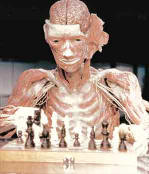| Net Abbey home page |
 In
case you have not yet heard of it, Body Worlds is a new kind of art using
human bodies preserved through a clever process called Plastination
invented by a German Doctor. A simplified description of
Plastination (very simplified) is removing all bodyfat and replacing
bodily fluids with plastic material - this preserves the body well, and
also removes any odor associated with the dead. In
case you have not yet heard of it, Body Worlds is a new kind of art using
human bodies preserved through a clever process called Plastination
invented by a German Doctor. A simplified description of
Plastination (very simplified) is removing all bodyfat and replacing
bodily fluids with plastic material - this preserves the body well, and
also removes any odor associated with the dead.Body Worlds does not steal it's cadavers for use in these exhibits but rather seeks donors. But the donors are told that this is to mainly to educate medical students and physicians. This is definitely a misrepresentation, as Body World's main purpose seems to be to provide a sort of macabre art show to the public. It would seem that students are better educated through photos or actual dissections. As Body Worlds is mostly art (it's the figure sculptures which most attract viewers), it doesn't give that much scientific information to the average person who doesn't really know what he/she is looking at. (small recorders are offered to the public - at a price of course - to carry through the exhibit - these have a commentary on the different figures etc but again, I'm sure most folks listening to this, will not understand a lot of it.) When it visited my city, for several months, about 2000 visitors a day or more came to see it. That averaged out to about $36,000 bucks a day gross profit or 1 million bucks a month (or more). The gross profits do pay some expenses (the hosting facility for example) and I'm sure the process is not cheap (especially the sculpture part of it). But I'm also fairly certain that the stock holders of BodyWorks and the inventor are not living in "dogtown" either. Especially that there are 3 such exhibits traveling the world. Since it IS so profitable one wonders why they do not give the survivors of the donors, some kind of royalties - this is not being done at present (and there seems no plan for doing so in the future). In a book on Body Worlds which is sold in a gift store adjoining the exhibit, there are several articles defending the morality of the exhibit. One argument is "isn't this the same thing that Christians have done for centuries in preserving relics of their saints? We have just found a better way to do this now." (The Body Worlds inventor is said to have offered the Plastination process to the Catholic church for preserving John Paul II, an offer which was turned down). However, it isn't the same as relics because the relic reminds of the saint and promotes respect for the saint's body, their Temple of the Holy Spirit in life whereas in Body Worlds, they destroy the identity of the corpse to render it "neutral" to survivors, thus reducing the person's body to a piece of meat and a sculpturing media and then, display the bodies, often in rather undignified ways (brain exposed etc). Whereas relics are a way to pray and be reminded of God, Body Worlds seems first, a way to showcase the work of the inventor and his assistants, and second, to bring in a rather nice profit, with being educational, a side effect or repercussion rather than a main purpose. By calling it "science" rather than "art", they get around a lot of restrictions. For example, all of the figures, though stripped down to the muscle layer, have in tact genitalia (which is NOT muscle) and/or in tact breasts (with nipples) which is to me, thinly disguised nudity but under their science veneer, they escape most of the usual criticisms. Science is a religion by itself in our post Christian world and so anything which calls itself science is looked upon with a sort of reverence. Most articles I read about it, though not necessarily awed by it, seemed almost afraid of openly criticizing it. In the Bodyworlds book and also from some quotes posted on site, the creators of this exhibit show a definite non Christian belief in death (one ceases to exist) and a covert scorn toward religionists (some of whom have objected to the exhibit). My hubby called it a circus side show - I found it mildly interesting but somehow felt the need to take a spiritual bath after the visit. It flaunts all the restrictions and respect usually given the dead and hides under its claim to be science. Some of the figures though de-personalized and "artified" are still quite macabre in nature. The exhibit seems to be fairly well accepted with even many clergy being neutral or mildly approving of it. But somehow, at least some of us, feel there is a line crossed there which would have been better left, uncrossed. Is it worth seeing? I guess that would depend. If you are a medical provider who has no qualms about this sort of exhibit, you might find it somewhat interesting. If you enjoy circus side shows, you might enjoy it also. But for many of us - it's way overpriced and dealing with the crowds and long waits in line in addition to the moral issues, may not be worth the yield of the exhibit. Body Worlds a Christian prospective
|